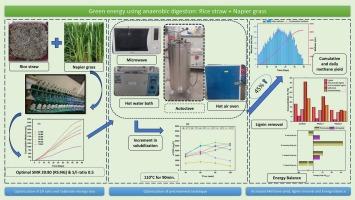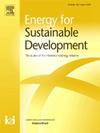Harnessing biomethane through thermally enhanced co-digestion of Rice straw and Napier grass
IF 4.9
2区 工程技术
Q2 ENERGY & FUELS
引用次数: 0
Abstract
Rice straw (RS), an abundant agricultural residue in India, is often subjected to open-field burning, contributing to severe environmental pollution. However, its potential for energy through biogas production remains underutilized due to its high carbon to nitrogen (C/N) ratio and seasonal availability. This study proposes a green pathway through anaerobic co-digestion (AnCoD) with perennial energy grass, Napier grass (NG). The maximum methane yield was achieved at a substrate-to-inoculum (S/I) ratio of 0.5. Among various substrate mixing ratios (SMR) tested, SMR 20:80 (RS: NG) yielded 200.6 mL/g-VSadded. To further enhance the energy recovery, thermal pretreatment techniques including autoclave, hot air oven, hot water bath and microwave were applied. At respective optimum temperatures, these pretreatment techniques boosted the soluble chemical oxygen demand (sCOD) by 2.3, 1.83, 1.57 and 1.56 folds, respectively, compared to the untreated sample. Further, the thermally enhanced co-digestion study augmented biomethane by 1.45 times (291.86 mL/g-VSadded) compared to untreated co-digestion (200.6 mL/g-VSadded), highlighting improved biodegradability of lignocellulosic biomass. The structural disruption in lignocellulosic structure upon autoclave pretreatment was confirmed through Fourier Transform Infrared Spectroscopy (FTIR) and Field Emission Scanning Electron Microscopy (FESEM) instrumental study. Although the net energy balance of pretreatment appeared slightly negative compared to total energy, a pilot scale techno-economic-environmental assessment is necessary to evaluate the feasibility and potential benefits of this co-digestion strategy.

利用生物甲烷通过热增强稻秸秆和纳皮尔草的共同消化
水稻秸秆是印度丰富的农业秸秆,经常被露天焚烧,造成严重的环境污染。然而,由于其高碳氮比(C/N)和季节性可用性,其通过沼气生产的能源潜力仍未得到充分利用。本研究提出了一种多年生能量草(Napier grass, NG)厌氧共消化(AnCoD)的绿色途径。底物与接种物(S/I)比为0.5时甲烷产量最大。在不同的底物混合比(SMR)中,SMR 20:80 (RS: NG)得到200.6 mL/g-VSadded。为了进一步提高能量回收率,采用了热压罐、热风炉、热水浴和微波等热预处理技术。在各自的最佳温度下,与未处理样品相比,这些预处理技术分别使可溶性化学需氧量(sCOD)提高了2.3倍、1.83倍、1.57倍和1.56倍。此外,与未处理的共消化(200.6 mL/g- vsadd)相比,热强化共消化研究使生物甲烷增加了1.45倍(291.86 mL/g- vsadd),突出了木质纤维素生物质的生物降解性。通过傅里叶变换红外光谱(FTIR)和场发射扫描电镜(FESEM)仪器研究,证实了高压灭菌预处理对木质纤维素结构的破坏作用。虽然预处理的净能量平衡与总能量相比略显负,但有必要进行中试规模的技术-经济-环境评估,以评估这种共消化策略的可行性和潜在效益。
本文章由计算机程序翻译,如有差异,请以英文原文为准。
求助全文
约1分钟内获得全文
求助全文
来源期刊

Energy for Sustainable Development
ENERGY & FUELS-ENERGY & FUELS
CiteScore
8.10
自引率
9.10%
发文量
187
审稿时长
6-12 weeks
期刊介绍:
Published on behalf of the International Energy Initiative, Energy for Sustainable Development is the journal for decision makers, managers, consultants, policy makers, planners and researchers in both government and non-government organizations. It publishes original research and reviews about energy in developing countries, sustainable development, energy resources, technologies, policies and interactions.
 求助内容:
求助内容: 应助结果提醒方式:
应助结果提醒方式:


